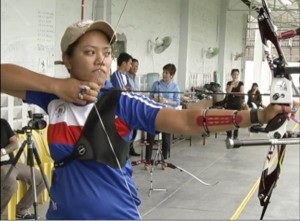SAN FRANCISCO — I regret that my son and I did not push through with our planned trip last month to Ogden, Utah to watch the US-leg of the World Cup of Archery.
We missed seeing Filipino archers Mark Javier and Rachel Cabral make the cut for the upcoming Olympics in London.
They face an uphill battle in a sport dominated by the Koreans. But the Filipino Olympian archers deserve our support competing in a sport my sons and I have fallen in love with.
Nine months ago, my eldest son and I gave archery a try. We’ve been hooked ever since.
We’ve shot pretty much every day these past weeks, sometimes spending as many as five hours at a range in a wooded area in the Oakland Hills.
It’s a beautiful spot, surrounded by Redwood trees and thick vegetation. It’s summer now and the heat can be intense in the East Bay, but not at the range where it’s always cool. Sometimes you see fog rolling over the treetops.
It’s a perfect place to practice an ancient sport. Archery has been part of many of ancient civilizations.
Some Philippine tribes are known to be expert archer hunters. At the Oakland range, Ishi, the famous Native American who stunned American society when he emerged from isolation in the hinterlands of Northern California, was known to have taught archery to locals. The range itself, which includes a unique shooting trail that winds up and down the hill, was created in 1939.
Archery has gotten more popular here recently, the attention spurred by such movies as Brave, The Hunger Games and even Lord of the Rings.
I suspect that it will attract a bit more attention again in the next few weeks with the Olympics. Globally, it’s also growing as shown by the World Cup competitions which began just a few years ago.
But this is a sport that is more than just about competing. At the Oakland range, we’ve met and made friends with fellow archers of different backgrounds.
There are the hunter types with impressive looking, and incredibly precise compound bows. There are the New Age, artist-types and seniors with elegant looking traditional recurve bows or long bows. There are families, couples with kids sometimes as young as five.
In fact, my eldest son and I eventually drew his younger brother, who is 7, into the sport. It’s a new experience for the three of us.
My sons and I have had a blast. I particularly enjoy the Zen-like experience of shooting arrows in a secluded spot surrounded by tall ancient trees.
There’s actually a Japanese form of archery as meditation called Kyudo. We some some of them practicing it at the range, performing rituals, elaborate and refined.
It’s fascinating to watch, even though I’ve read and heard that it takes years to practice. It’s about using a bow and arrows to pull back, feel and accept the weight and tension and then let go.
I may not practice or understand the rituals of Kyudo, but I get it I think.
Archery is my form of meditation and has been my way of being present and letting go.
When I’m not present, when my mind is wandering too much, my shots are all over the target. When my mind is at ease and fully present, I can feel each shot, the shooting is consistent, the arrows forming a tight group more or less in the center of the target.
My eldest son says he kind of gets it too — though he still finds the Zen stuff weird.
A Web video on the Zen of archery still makes us both crack up. “You may hit the target but miss yourself,” the narrator says.
“What in the world does that mean?” my son asks.
But I think and sense that he gets it, in the same way that I think and sense that I get it.
It’s hard to explain. The most important thing, I guess, is the fun we have and the peace we enjoy, in that secluded spot, surrounded by giant trees, in the hours we spend drawing a bow, taking aim and letting go.
On Twitter @KuwentoPimentel. On Facebook atwww.facebook.com/benjamin.pimentel
